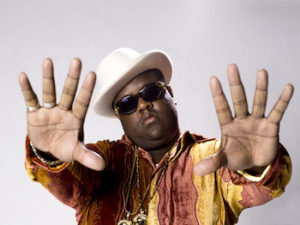
Notorious B.I.G.
On this date, we mark the birth of Notorious B.I.G. in 1972. He was a Black rap singer and entertainer.
Christopher Wallace (his name at birth) grew up in the district of Bedford-Stuyvesant, Brooklyn, New York. He soon graduated to a life of selling drugs and acting as a teenage lookout. He first rapped under Biggie Smalls as part of the Old Gold Brothers neighborhood group. He also made his demo recording, a copy of which was eventually sent to Mister Cee, Big Daddy Kane’s D.J. The demo ended up at The Source, America’s best-selling rap periodical, which gave it a great review.
This attracted the attention of Sean "Puffy" Combs, who signed him. Having now adopted the stage name Notorious B.I.G., Wallace made his recording debut in 1993, backing Mary J. Blige on “Real Love.” He also appeared on Supercat’s “Dolly, My Baby.” His first solo effort was “Party and Bullshit,” included in the movie Who’s The Man soundtrack. His debut album followed in 1994. “ Ready To Die” became a major hit thanks to the inclusion of singles such as “Juicy,” “One More Chance,” and “Big Poppa,” the latter a U.S. Top 10 hit which was voted Billboard “s rap single of the year. He received several end-of-year awards in The Source, as the album achieved platinum sales.
B.I.G. went to the U.K. to support R. Kelly at Wembley Stadium in London and was a guest on Michael Jackson’s HIStory — Past, Present and Future Book 1. However, despite his elevation to such exalted company, Notorious B.I.G. never left his roots (the ghetto) behind. He formed M.A.F.I.A. with some of his former hustler colleagues, releasing an album, “Conspiracy,” in 1995. He was also involved in sundry episodes involving violence, such as a quarrel with a promoter in New Jersey and his attempt to take a baseball bat to autograph hunters (for which he received a 100-hour” community service sentence). He was also involved in a running feud with rapper TuPac, who was convinced of B.I.G.’s involvement in a 1994 robbery in which he was injured.
Their disagreement soon festered into a bitter feud between the East and West Coast American rap scenes. When TuPac was murdered, B.I.G.’s non-attendance at a rap peace summit in Harlem was widely criticized. Instead, he began work on a second album entitled, prophetically, Life after Death. Its cover featured the rapper standing next to a hearse with the license plate B.I.G. He never lived to see its official release. He was gunned down after leaving a party in California on March 9, 1997. Subsequent guesses indicated that his murder was in retaliation for Tupac’s killing.
Released three weeks later, “Life After Death” went straight to the top of the U.S. charts. In 1999, he was back in the charts with “Born Again,” a motley collection of unreleased material.
Rap Music and the Poetics of Identity
By Adam Krims
Cambridge University Press, 2000,
ISBN # 0521632684